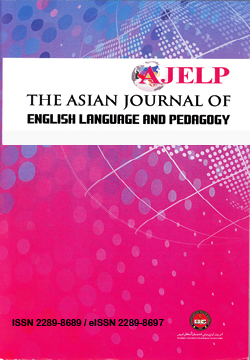English teachers’ readiness to teach online during the COVID-19 outbreak
DOI:
https://doi.org/10.37134/ajelp.vol9.1.2.2021Keywords:
e-learning, online teaching, online learning, digital learning, remote learning, teachers’ readiness, COVID-19Abstract
The study aimed at investigating Malaysian English teachers’ readiness to teach online during the recent COVID-19 outbreak and the problems they faced while conducting online lessons. Data for the study were randomly obtained online from 103 respondents, using a questionnaire. Findings showed a positive indication of English teachers’ readiness for online teaching yet there were a few problems that need to be addressed, especially pertaining to the equitable network coverage and facilities, implying the needs for the authorities to provide ample support and innovations to assist both teachers and learners in achieving meaningful online learning.
Downloads
References
Anagün, Ş. S. (2018). Teachers’ perceptions about the relationship between 21st century skills and managing constructivist learning environments. International Journal of Instruction, 11(4), 825–840. https://doi.org/10.12973/iji.2018.11452a
Bailey, Craig. J., & Card, K. A. (2009). Effective pedagogical practices for online teaching: perception of experienced instructors. Internet and Higher Education, 12(3–4), 152–155. https://doi.org/10.1016/j.iheduc.2009.08.002
Bao, W. (2020). COVID ‐19 and online teaching in higher education: A case study of Peking University . Human Behavior and Emerging Technologies, 2(2), 113–115. https://doi.org/10.1002/hbe2.191
Baran, E., Correia, A. P., & Thompson, A. (2011, November). Transforming online teaching practice: Critical analysis of the literature on the roles and competencies of online teachers. Distance Education. https://doi.org/10.1080/01587919.2011.610293
Baran, E., & Correia, A.-P. (2014). A PD framework for online teaching. TechTrends, 58(5), 96–102. Retrieved from https://link-springer-com.proxy.library.uu.nl/content/pdf/10.1007%2Fs11528-014-0791-0.pdf
Basilaia, G., & Kvavadze, D. (2020). Transition to Online Education in Schools during a SARS-CoV-2 Coronavirus (COVID-19) Pandemic in Georgia. Pedagogical Research, 5(4). https://doi.org/10.29333/pr/7937
Bolliger, D. U., & Wasilik, O. (2009). Factors influencing faculty satisfaction with online teaching and learning in higher education. Distance Education, 30(1), 103–116. https://doi.org/10.1080/01587910902845949
Cheok, M.L., Wong, S. L., Ahmad Fauzi Ayub, & Rosnaini Mahmud. (2017). Teachers' perceptions of e-learning in Malaysian secondary schools- frog VLE. Malaysian Online Journal of Educational Technology 5(2) .
Conrad, D. (2004). University instructors’ reflections on their first online teaching experiences. Journal of Asynchronous Learning Network, 8(2), 31–44. https://doi.org/10.24059/olj.v8i2.1826
Creswell, J. W., & Creswell, J. D. (2018). Research design: qualitative, quantitative, and mixed methods approaches (5th ed. ). Los Angeles: SAGE Publications, Inc.
Daniel, S. J. (2020). Education and the COVID-19 pandemic. Prospects, 0123456789. https://doi.org/10.1007/s11125-020-09464-3
Doghonadze, N., Aliyev, A., Halawachy, H., Knodel, L., & Adedoyin, A. S. (2020). The Degree of Readiness to Total Distance Learning in the Face of COVID-19 Teachers’ View (Case of Azerbaijan, Georgia, Iraq, Nigeria, UK and Ukraine). Journal of Education in Black Sea Region, 5(2), 2–41. https://doi.org/10.31578/jebs.v5i2.197
Garba, S. A., Byabazaire, Y., & Busthami, A. H. (2015). Toward the use of 21st century teaching-learning approaches: The trend of development in Malaysian schools within the context of Asia Pacific. International Journal of Emerging Technologies in Learning, 10(4), 72–79. https://doi.org/10.3991/ijet.v10i4.4717
Goodyear, P., Salmon, G., Spector, J. M., Steeples, C., & Tickner, S. (2001). Competences for online teaching: A special report. Educational Technology Research and Development. Association for Educational Communication and Assn for Educational Communication and Technology. https://doi.org/10.1007/BF02504508
International Association of Universities. (2020). The impacts of COVID-19 on HE worldwide-Resources for for Higher Education Institutions (p. 27). Retrieved from https://www.auf.org/nouvelles/actualites/lauf-lancebulletin-de-veille-electronique-
International Baccalaureate. (2020). Online learning , teaching and education continuity planning for schools. International Baccalaureate Organization, 1–13. Retrieved from ibo.org
Khalidi, J. R., Khalidi, J. R., Sundaram, K., Hamid, H. A., & Romadan, J. (2020). Covid-19 and Unequal Learning. Khazanah Research Institute, (April), 1–8.
Koo, A. C. (2008). Factors affecting teachers’ perceived readiness for online collaborative learning: A case study in Malaysia. Educational Technology and Society, 11(1), 266–278.
Kumar, J. A., Bervell, B., & Osman, S. (2020). Google classroom: insights from Malaysian higher education students’ and instructors’ experiences. Education and Information Technologies. https://doi.org/10.1007/s10639-020-10163-x
Martin, F., Budhrani, K., & Wang, C. (2019). Examining faculty perception of their readiness to teach online. Online Learning Journal, 23(3), 97–119. https://doi.org/10.24059/olj.v23i3.1555
Norazlin Mohd Rusdin. (2018). Teachers ’ readiness in implementing 21st century learning.
Norezan Ibrahim, Siti Fairuz Dalim, Rosilawati Sueb & Azzlina Adzra'ai. (2019). Trainee teachers’ readiness towards 21st century teaching practices. Asian Journal of University Education, 15(1), 110–120. International Journal of Academic Research in Business and Social Sciences, 8(4), 1293–1306. https://dx.doi.org/10.6007/IJARBSS/v8-i4/4270
Nyanaambigai, R., & Nur Hidayah Zainul. (2020). Exploring malaysian polytechnic lecturers’ readiness in embracing 21st century education: an institutional case study. International Journal of Advanced Research in Education and Society, 1(3), 1-7.
Oliver. R. (1999). Exploring strategies for online teaching and learning. Distance Education, 20(2), 240-254. https://doi.org/10.1080/0158791990200205
Phan, T. T. N., & Dang, L. T. T. (2017). Teacher readiness for online teaching: a critical review. The International Journal on Open and Distance e-Learning, 3(1), 1-16.
Prime Minister Office. (2020). Restriction of Movement Order. Retrieved from https://www.pmo.gov.my/2020/03/movement-control-order/
Ritanjali, P., Praveen Ranjan, S., & Dheeraj, S. (2018). Online learning: Adoption, continuance, and learning outcome—A review of literature. International Journal of Information Management, 43, 1-14.
Sun, A., & Chen, X. (2016). Online education and its effective practice: A research review. Journal of Information Technology Education: Research, 15, 157-190. http://www.informingscience.org/Publications/3502
The Organisation for Economic Co-operation and Development. (2020). Flattening the covid-19 peak: Containment and mitigation policies Flattening the COVID-19 peak: Containment and mitigation policies. Retrieved from https://read.oecd-ilibrary.org/view/?ref=124_124999yt5ggxirhc&Title=Flattening%20the%20COVID-19%20peak:.Containment%20and%20mitigation%20policies
TUAC Secretariat Briefing. (2020). Impact and Implications of the COVID 19-Crisis on Educational Systems and Households. Retrieved from https://tuac.org/news/the-impact-and-implications-of-the-covid-19-crisis-on-educational-systems-and-households/
UNESCO. (2020). COVID-19 Impact on Education. Retrieved from https://en.unesco.org/covid19/educationresponse
van Laar, E., van Deursen, A. J. A. M., van Dijk, J. A. G. M., & de Haan, J. (2017). The relation between 21st-century skills and digital skills: A systematic literature review. Computers in Human Behavior, 72, 577–588. https://doi.org/10.1016/j.chb.2017.03.010
Voogt, J., Erstad, O., Dede, C., & Mishra, P. (2013). Challenges to learning and schooling in the digital networked world of the 21st century. Journal of Computer Assisted Learning, 29(5), 403–413. https://doi.org/10.1111/jcal.12029
Zhu, X., & Liu, J. (2020). Education in and after COVID-19: immediate responses and long-term visions. Postdigital Science and Education. https://doi.org/10.1007/s42438-020-00126-3





